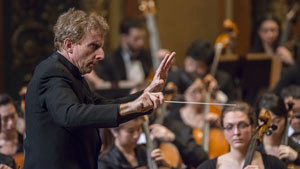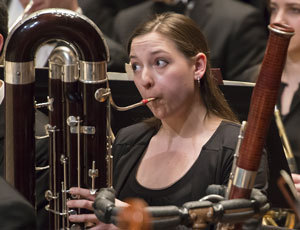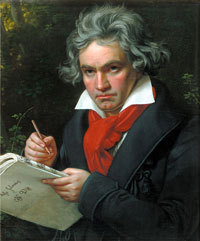 Have you ever been knocked sideways by a performance of a work that you know really well? In fact, so well, that you have approached past performances more as duty rather than a pleasure. It happened to me recently with the Beethoven Ninth Symphony, one of the most popular and often performed works in the repertoire. It took place in NEC's Jordan Hall with Calderwood Director of Orchestras Hugh Wolff and our Philharmonia Orchestra, choruses (NEC Concert Choir -- Erica J. Washburn, director and the Tufts University Chamber Singers -- Jamie Kirsch, director), and a quartet of beautifully blended vocal soloists (Suzanne Grogan, soprano; Jessica Harika, mezzo-soprano; David Charles Tay, tenor; Vincent Turregano, baritone).
Have you ever been knocked sideways by a performance of a work that you know really well? In fact, so well, that you have approached past performances more as duty rather than a pleasure. It happened to me recently with the Beethoven Ninth Symphony, one of the most popular and often performed works in the repertoire. It took place in NEC's Jordan Hall with Calderwood Director of Orchestras Hugh Wolff and our Philharmonia Orchestra, choruses (NEC Concert Choir -- Erica J. Washburn, director and the Tufts University Chamber Singers -- Jamie Kirsch, director), and a quartet of beautifully blended vocal soloists (Suzanne Grogan, soprano; Jessica Harika, mezzo-soprano; David Charles Tay, tenor; Vincent Turregano, baritone).
 This concert was truly out of the ordinary. So much so that it became a voyage of rediscovery for me, reawakening me to the astonishing originality and courage of the work. It was the Ninth's power and energy that seemed to engage these young performers so intensely. They rose to the music, grabbed the ferocious engine of its ideas and presented something unique. It was a "first" performance of a type only young musicians can produce, operating at 200 percent without thought of tomorrow's world. For them, only the moment seemed to exist. The effect it had on me was deeply emotional -- something that the capacity crowd also seemed to experience.
This concert was truly out of the ordinary. So much so that it became a voyage of rediscovery for me, reawakening me to the astonishing originality and courage of the work. It was the Ninth's power and energy that seemed to engage these young performers so intensely. They rose to the music, grabbed the ferocious engine of its ideas and presented something unique. It was a "first" performance of a type only young musicians can produce, operating at 200 percent without thought of tomorrow's world. For them, only the moment seemed to exist. The effect it had on me was deeply emotional -- something that the capacity crowd also seemed to experience.
Certainly the most difficult of his symphonies, the Ninth was written towards the end of Beethoven's life in 1824 in Vienna. He had always shown great interest in philosophy and literature, and Goethe, Schiller, and Immanuel Kant were frequent sources of inspiration. For this symphony, Beethoven embraced Schiller's humanist poem "Ode to Joy" which celebrates the eternal brotherhood of mankind and -- in a revolutionary act -- set it to music in the last movement.
 This part of the symphony has become recognizable to everyone. It appears often as a hymn or anthem played and sung on its own at churches, schools, graduations and on the soundtrack of the occasional Bruce Willis movie. But for Beethoven to reach this most familiar moment, he had to cover a distance of exploration no one had ever traveled before. A choral finale for an orchestral symphony was new territory for everyone and he knew it. You can almost hear the strangeness of the landscape in the work.
This part of the symphony has become recognizable to everyone. It appears often as a hymn or anthem played and sung on its own at churches, schools, graduations and on the soundtrack of the occasional Bruce Willis movie. But for Beethoven to reach this most familiar moment, he had to cover a distance of exploration no one had ever traveled before. A choral finale for an orchestral symphony was new territory for everyone and he knew it. You can almost hear the strangeness of the landscape in the work.
The first movement sounds almost uncertain, as if groping its way to an unknown destination. It does not demonstrate Beethoven's usual poise and confidence as he knows that he is pushing boundaries. The second movement returns temporarily to more familiar territory, with an immensely powerful motif that incorporates the timpani almost as an independent soloist. The slow movement is a steady flow of variations with moments that foreshadow the great last movement.
 Then comes the finale -- with what must be among the most agonized openings in any of his works. There is a titanic outburst of dissonance. As if to prove to us that this eruption is really integrated into the whole structure, Beethoven brings back several sections from each of the previous three movements. Interspersed between these "recollections," the cellos and basses are given "human," but wordless voice, speaking and challenging, only to suddenly become almost silent as they whisper that so famous anthem. For me, this is one of the most moving parts of the symphony, so unspeakably simple, authentic, and courageous. It stopped me completely at this performance. Then the full orchestra takes up the anthem, intimately at first, then in a more stentorian tone, before the dissonance explodes again, this time introducing the first soloist, the baritone, with "Freude," which is shouted back at him by the male voices in the chorus.
Then comes the finale -- with what must be among the most agonized openings in any of his works. There is a titanic outburst of dissonance. As if to prove to us that this eruption is really integrated into the whole structure, Beethoven brings back several sections from each of the previous three movements. Interspersed between these "recollections," the cellos and basses are given "human," but wordless voice, speaking and challenging, only to suddenly become almost silent as they whisper that so famous anthem. For me, this is one of the most moving parts of the symphony, so unspeakably simple, authentic, and courageous. It stopped me completely at this performance. Then the full orchestra takes up the anthem, intimately at first, then in a more stentorian tone, before the dissonance explodes again, this time introducing the first soloist, the baritone, with "Freude," which is shouted back at him by the male voices in the chorus.
And now we start our journey into Beethoven's celebration of this poem and anthem, a journey which takes us to new worlds -- a curious peasants' march, a chorus used in an almost instrumental way, the four soloists challenged by some of the most difficult vocal music imaginable, a great double fugue. Now certain of his direction and destination, Beethoven commands this quest with utter assurance, the pace driven, breathless. He the explorer, the performers, and we the listeners are transfixed and enthralled by the glory we find -- the unequivocal optimism for mankind.
Last week, we took this journey again and it truly gladdened the heart. In that moment of discovery and rediscovery, the music transformed our world into a place of magic and peace. And I was left with the strongest feeling that the future of music is in a great place, in the hands, minds, and souls of these extraordinary young musicians.
(To sample a bit of this performance, listen to the clip below of the Scherzo movement. If you like what you hear and want to listen to the whole symphony in audio form, go to NEC's InstantEncore page here.).